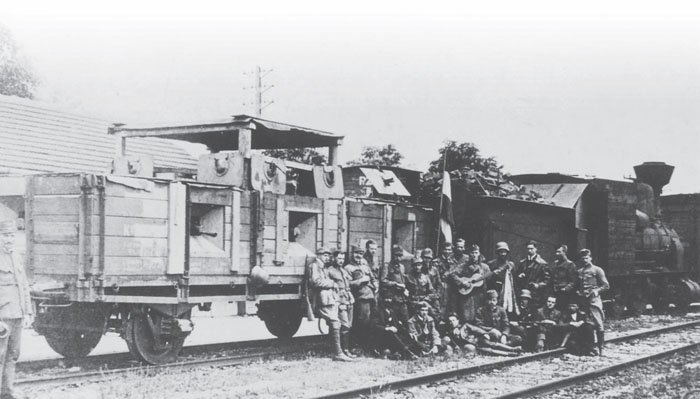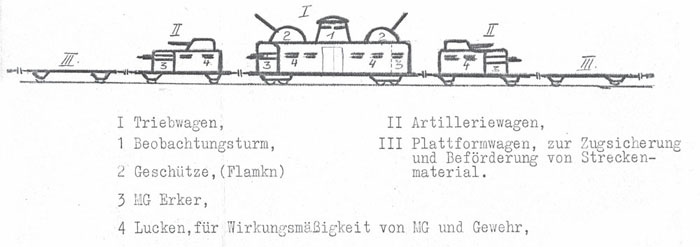
Before considering the history of Austrian armoured trains, it is first necessary to detail the successive states that succeeded the Empire, then the separate countries which arose from it. The armoured trains of the latter will be found in the corresponding country’s chapter.
The Austrian Empire lasted up until 1867. In that year Emperor Franz Josef I was crowned King of Hungary, and the new Empire (the Dual Monarchy) thus created lasted until 1918. It united the Imperial Crown of Austria (Austria, Bohemia and Galicia) with the Royal Crown of Hungary (Hungary and Croatia-Slavonia), and in 1908 Bosnia-Herzegovina officially joined the Dual Monarchy. After 1918 the Austro-Hungarian Empire, dismantled by the Treaty of St Germain, fractured into five separate nation-states: Austria, Hungary, Czechoslovakia, Poland and the Kingdom of Serbia (which included the territories of the Croats and the Slovenes). Parts of former Imperial territory were also annexed by Romania and Italy. The Treaties of St Germain (10 September 1919) and Trianon (4 June 1920) established the new frontiers of Austria and Hungary. The First Austrian Republic existed until 12 March 1938 when it was absorbed into the German Reich.
Concerning the first armoured trains of the Austrian Empire, an article in a French military journal published in 1851 stated that in Austria ‘for several years now wagons [have been built] so arranged as to allow infantry platoons to bring into play their weapons as necessary’. This probably refers to trains built to counter the revolution of 1848.
After November 1918, the First Austrian Republic was affected by problems caused in large part by the Empire’s defeat, and then by the Wall Street Crash of 1929. Demonstrations in 1918–19 led to the construction of an armoured train in January 1919 in the state railway workshops in Villach. The train, designated PZ XIII (following on from the numerical series of the Austro-Hungarian armoured trains), went into action in Carinthia and lost its locomotive (one of the Class 29 C-n2 series). Wagons Nos 1 and 2 were converted from Types G and O respectively, with improvised ballast protection and armed with heavy machine guns. After derailing on 31 May 1919, Wagon No 2 was rebuilt, this time with improved armour protection and an observation cupola. In addition, it could now deploy a 37mm Italian M 15 gun. The train was disarmed following the cessation of hostilities between Austria and Yugoslavia on 6 June 1919.

PZ XIII in its original form in January 1919. Note the wooden protection on the cab of the engine. The thickness of the ballast protection can be gauged from the openings for the 8mm Schwarzlose machine guns.
(Photo: All Rights Reserved)

Civil war broke out in February 1934, setting government supporters against the socialists and revolutionaries. At that time trains were armoured to ensure the security of the lines of communication.
On 27 January 1938 Panzerzüg M 39, a modern armoured train with electric propulsion, was designed by Abteilung PV1 which produced the sketch above. At that stage the armour protection had not been finalised, in contrast to the optical equipment and the armament.
The 1938 sketch shows the overall layout of the projected train. The central railcar would have mounted 40mm M 36 anti-aircraft guns (licence-built Bofors) and four M7/12 heavy machine guns. Each artillery wagon was to have been armed with a turret-mounted 100mm M 14 or M 38 howitzer and two heavy machine guns. Finally, thirteen men were to form the crew of the railcar and an assault group would be divided between the two wagons. Work on the project was brought to a halt by the Anschluss.
SOURCES:
‘Des Chemins de Fer considérés au point de vue militaire’, Le Spectateur Militaire Vol 50 (June 1851), p 306.

One of the six Panzerzüg Types M 33 ordered by the Bundesheer, photographed on 13 February 1934 in Vienna-East Station. In front and rear of the 2-6-2 Class 73 kkStB engine (with armour protecting the upper part of the cab door) are two Type O wagons, with internal armour protection. Trench shields protect the riflemen, while in the centre of the wagon is a Schwarzlose M1907/12 machine gun behind its characteristic shield.
(Photo: Paul Malmassari Collection)
1. Pionier und Verkehrstechnik, Engineers and Transport Technical Section.